|
|
 |
There are three pages to this section. Click the link below to go directly to Page 2, if you have already read
about all three days we spent in Chattanooga on our way upriver. You can also go to Page 2 by clicking the link at the
bottom of this page.
If you want to go directly to Page 3, which begins our travels downriver, and includes our second stop in Chattanooga,
there is a link for Page 3 below, and another one at the bottom of Page 2.
Click here to go to Page 2.
Click here to go to Page 3.
|
 |
|
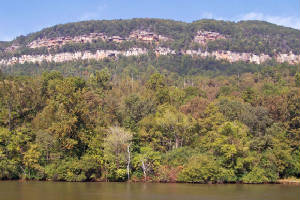
|
| Grand Canyon of the Tennessee |
October 14, 2005 Shellmound Recreation Area to Chattenoooga
38.3 miles
Most of our cruising today was through a portion of the river known as the "Grand Canyon of the Tennessee."
The river was narrow, with lots of bends as it flowed between mountains rising steeply on either side. The sun shone on
us, the temperatures hit the low 80s, the scenery was majestic, and we declared it yet another in a long series of truly spectacular
cruising days.
The drought has given us beautiful cruising weather, but has delayed the color change in the leaves. An
article in the Chattenooga Times Free Press cited University of Tennessee Extension forestry specialist Dr.
Wayne Clatterbuck, predicting the fall color this year will be two to three weeks later than usual, and not as vivid as the
past. We probably can't expect to see much fall color until the last week in October, if Dr. Clatterbuck is right.
By then, we may well be so far south that we are out of the color zone.
As we neared Chattenooga, Lookout Mountain rose 2000 feet tall ahead of us. Its ridge extends 100
miles from Tennessee into Georgia and Alabama. Lookout Mountain was the site of the last battle of the American Revolution,
and one of the bloodiest battles of the Civil War. In November 1863, the "Battle Above the Clouds" was fought on the
mountain, and 34,000 soldiers lost their lives. Today Lookout Mountain is the site of the Chickamauga Chattenooga National
Military Park, the nation's oldest and largest military park.
A divided highway ran along the base of the mountain, paralleled the river, and headed into Chattenooga.
Industrial sites lined the river shore as we approached the city. Then, the river took a bend, we passed under a bridge,
and the striking angled glass roofs of Chattenooga's two Aquarium buildings came into view.
The dockmaster directed us to tie up on the wall right in front of the Aquarium Campus. Our cruising
friends Connie and Rick on CORI were waiting on the wall to grab our lines. Their boat was already docked right behind
our spot. We haven't seen Connie and Rick since we cruised with them in the North Channel, and were glad our paths finally
crossed again.
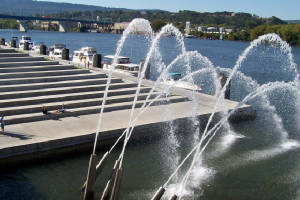
The Chattenooga Marina offers a great location, but not much else -- no laundramat (and none anywhere nearby
in town), no showers or rest rooms. Half its spots are on floating docks, and the other spots, where we were tied up,
are on a cement wall with a stair step design. The dockmaster told us to tie the boat up loosely, because the water
level could change up to four feet when they let water out of the dam upstream. It was clear that the people who designed
the wall didn't understand boats or the full extent of water level fluctuations. If the water went down significantly,
fat black rubber bumpouts built into the side of the cement wall could catch beneath boat rub rails and damage them.
If the water went up as far as the dockmaster said it could, we would be left with no wall surface for our fenders to
touch, leaving the side of the boat a few inches below the waterline rubbing against concrete.
The water did in fact go down about four feet overnight, but we had added a fender to protect us from the
rubber bumpout on the wall, and we survived the drop without unpleasant surprises. Dick did get up in the middle of
the night to check on the situation, and when he noticed the big change in water level, he checked out our friends' boats,
too. Fortunately, none needed a surprise wake-up call.
Other than that minor dockage detail, Chattenooga is a wonderful city. A quick trip to the Visitor's
Center located in the Aquarium confirmed that we could stay here for three or four days and never run out of things to see
and do. We decided to stay for the next two days, and enjoy as much as we could.
CORI made dinner reservations for 14 at a restaurant that came highly recommended from other cruisers
who had gotten here before we did, and our little cruising group of six went to dinner with Connie and Rick and the crews
of Kokapelli, R Enchantment, and another boat we hadn't met before.
When we emerged from dinner, the street in front of the restaurant was closed to traffic and filled with
sleek racing boats on trailers here for races on the lake above the nearby dam. The boats had fancy paint jobs
and were covered with sponsor logos.
One of the boat crew members was especially talkative, and told us his boat was a past world champion in
its class. He was the navigator, and worked with an ironman driver who can steer and throttle at the same time.
Apparently, working the throttle on these boats requires some strength, and many crews have one person to handle the throttle,
while another steers). He said that the boats raced at 150 mph and more, but that to compare with land speeds you should
multiply by 1.6. We never did catch a rationale for this multiplier effect, but we did use it to figure out that we
cruise at a land speed equivalent of a little bit less than 15 mph, and he races at around 240 mph.
We went to bed exhausted from a very full day, stuffed from a very good dinner, and excited about exploring
Chattenooga over the next couple days.
October 15-16 Chattanooga
We spent Saturday wandering around town looking for geocaches and historical, architectural and cultural
points of interest. We eventually figured out that Chattanooga doesn't have an "e," but it takes too long to edit
stuff that has already been published in my website program, so I am leaving the misspellings in my previous entries, much
as it pains me.
Our boat is docked in an area that a historic marker indicates is the beginning of the Trail of Tears, a
particularly grim episode in our nation's shameful history of dealing with its native people. In May 1838, the army
rounded up Cherokees in this area who refused to move to Oklahoma under the terms of a Treaty of Removal signed by three tribal
leaders whose authority to sign away everyone's rights was in question. Those leaders gave up all the Cherokees' lands
east of the Mississippi in return for five million dollars and seven million acres of land in the west. They were later
assassinated.
The 15,000 Cherokees who refused to move under the terms of the treaty were placed in stockades in Tennessee
and Alabama. A small contingent of 3,000 were sent by boat down the Tennessee River, and the rest were marched west
in the fall and winter of 1838-39. The weather was harsh, and 4,000 died.
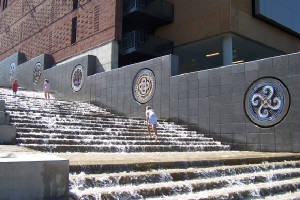
The Cherokees are remembered not only with a historic marker, but also with a fountain designed for a total
immersion experience. The fountain is a long stone staircase, with water cascading over the steps, and wading pools
on the landings of the stairs. Along the stone wall behind the stairs are large ceramic tile depictions of traditional
Cherokee sacred symbols. Their meanings are explained on brass plaques next to the fountain. We saw children of all
ages, and even teens, running up and down the steps and splashing in the water. Some adults even took off their shoes
and waded in without the excuse of a child in tow.
A crew was shooting a video of two parents and two children playing in the fountain as we began our day.
There are lots of other interesting water features around the aquarium complex. The water cannons
shown in the picture of the waterfront seem to run all day and all night, when they are lit with spotlights. There is
a meandering man-made stream that runs over a cement riverbed beside the path to the aquarium. On the side of the aquarium
facing the street, there is a massive grate with hundreds of little water fountain size streams of water rising less than
a foot above the grate. You can stomp on them or dance among them to your heart's content.
As we walked about town, we saw several old-style Coca-Cola ads painted on the sides of brick buildings
and walls. Chattanooga is proud to be home of the first Coca Cola bottler in the United States. In 1899, two prominent
citizens signed an agreement with Coca-Cola giving them exclusive bottling rights for most of the country, and they began
their bottling operation here shortly thereafter.
We learned lots of other history of Chattanooga. We tried to picture what the city looked like in
its heyday as a cotton port, when at peak periods, cotton bales lined the sidewalks and all the vacant lots for ten blocks
from the waterfront. We saw pictures of the city buried beneath flood waters so high that even roofs didn't show.
Thanks to the TVA dams, that is a sight that won't be repeated.
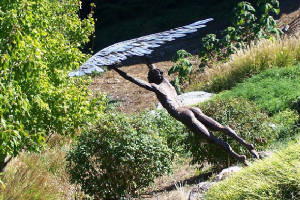
|
| My favorite sculpture |
We enjoyed walking through a neighborhood high on the bluffs overlooking the river. The Hunter Art
Museum is here, but we didn't have time for a visit. Instead, we just enjoyed the sculptures on the museum grounds,
as well as many sculptures in a nearby park.
At the end of our day of walking about, Karen and Frank made pizzas and we all convened aboard Geminelli
to share dinner and tales of how we spent our day around Chattanooga. The Dixie Belle riverboat left for
its sunset cruise with the calliope playing "Chattanooga Choo-Choo" and "Rocky Top," providing the perfect ambiance for a
day devoted to appreciating the history of this river city.
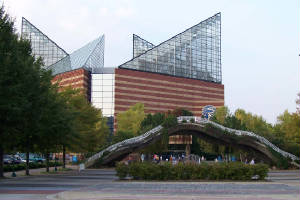
|
| Tennessee Aquarium |
We spent most of Sunday to throughly enjoying the Chattanooga Aquarium with Geminelli, Main
Course and CORI. The Aquarium has two buildings, one dedicated to rivers and one to oceans. It is
the largest freshwater aquarium in the world, and has the largest freshwater tank in the world. Some would say this
is only appropriate, since the Tennessee River has more species of fish than any other river in North America.
We started our visit in the River Journey building. The journey through the building begins with an
exhibit that has nothing to do with rivers, but is beautiful and captivating. It is an exhibit of sea horses and sea
dragons the Chattanooga Aquarium developed jointly with the Baltimore Aquarium. We lingered long, especially admiring
the sea dragons with leafy appendages that make them look more like exotic plants than animals.
Our visit took us through a little version of a cove forest in a greenhouse at the top of the aquarium building.
We learned that cove forests in this region are actually small rainforests, and they are home to about 4,000 species.
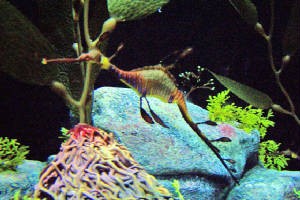
|
| Leafy Sea Dragon |
We touched a sturgeon. We saw all the game fish that the people we pass in fishing boats are
trying to catch. We got a much better understanding of what is going on under our boat as we travel the river, and what
all the development we see on its shores is doing to endanger the river's delicate balances. (Of course, building all
those dams that rerouted the river, changed its levels, made lakes out of valleys and messed with the natural flooding patterns
pretty much tossed the delicate balance concept out the window, but the Aquarium doesn't really go too much into that.)
We learned that the Tennessee River/Ohio River/Mississippi River system drains 40% of the land mass
of North America, including land in 31 states. When the water in this river system finally flows into the Gulf from
the mouth of the Mississippi, it is traveling at a rate of four million gallons per second!
Just doing the River Journey building took all morning. We went out to lunch with our friends, then
returned to do the Ocean Journey in the afternoon.
As in the River Journey building, one of the most fascinating exhibits here had little to do with
oceans. On the top of the Oceans building is a tropical greenhouse filled with flowers and butterflies. The butterflies
flutter freely, and light on people as well as flowers. I found it hard to leave. Dick left the hot and humid
greenhouse to wait for me in air conditioned comfort while I took a few more pictures, and enjoyed the colorful butterflies
flitting all around me just a little longer.
We touched several different kinds of rays and a couple sharks. We enjoyed the colorful reefs and
tropical fish. An exhibit of artfully lit sea nettles and jellyfish caught our fancy. By the time we finally left
the Ocean Journey building, we were feeling totally saturated with aquatic sensory input.
We headed back to the boat to relax. By relax, I mean that Dick changed the oil in both engines
and the generator, and I read and wrote. (I might have even slipped in a little nap.)
Click here to continue to Page 2.
|
 |
|
|
 |
|
|
 |
|
|
|
|
|
|
 |

